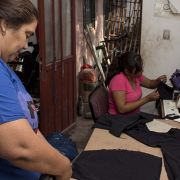Advances and stagnations in the rights of LGBTIQA + people: towards material equality
May 17 corresponds to the date on which the World Health Organization removed (31 years ago, in 1990) homosexuality from the list of mental illnesses. That is why on this day the “International Day for the Fight against Discrimination due to Sexual Orientation and Gender Identity” is celebrated and particularly in the province of Córdoba the “Provincial Day for Equality and Non-Discrimination due to Sexual Orientation, Identity and Gender Expression ”. These advances are accompanied by laws that demonstrate achievements but also obstacles in their implementation.
“Below, we offer a google translate version of the original article in Spanish. This translation may not be accurate but serves as a general presentation of the article. For more accurate information, please switch to the Spanish version of the website. In addition, feel free to directly contact in English the person mentioned at the bottom of this article with regards to this topic”
May 17 is a fundamental day to make visible and raise awareness about the multiple violence suffered by LGBTIQ + people.
By virtue of the incorporation of international human rights treaties into our constitution, eradicating discrimination based on gender is a duty assumed by the State and also a commitment by all of us who want to live in a more just and equitable society.
There are various tools to eradicate violence, one of them is the formation and creation of laws, which imply the recognition of rights. Among them we can name Law 26,485 on Comprehensive Protection to Prevent, Punish and Eradicate Violence; the 26,743 of gender identity; Law 26,150 on comprehensive sexual education; among other. Despite its recognition, in law there are two fundamental concepts: on the one hand, formal equality, and on the other, material equality. The first corresponds to what we have been talking about, the recognition and promotion of equal rights written in the law, but the second is the opposite. That is, it allows us to identify if what is written is reflected in everyday life and these rights are specified, generating real equality, or if they are simply statements narrated on paper.
According to updated data from Amnesty International, people who identify as lesbian, gay, bisexual, transgender or intersex, or are perceived as such, are at greater risk of being harassed and victims of violence because of their sexual orientation or gender identity. The life expectancy of the transvestite-trans population in Argentina is 35 to 41 years. In this sense, it is important to remember the case of Tehuel De La Torre, a trans boy who disappeared on March 11 of this year, when he left his home for a job interview. To this day Tehuel does not appear, there are few clues about his whereabouts since the last people who saw him alive do not provide information, and it is a case that does not have enough repercussion and dissemination in the hegemonic media. The Tehuel case highlights the reality of the country’s trans population: the situation of extreme vulnerability and exposure to multiple gender-based violence.
Among the discriminations that people suffer due to their sexual orientation or gender identity there are homophobia, lesbophobia and transphobia, which are irrational hatred towards people whose sexual orientation is different from heterosexuality and / or their gender identity does not matches your biological sex. An example of this is the rejection that was generated by a sector of Cordoba society towards the LGBTIQA + flag that was hung by the Municipality of the capital in Sarmiento Park. On that occasion, there were clear reactions of violence and hate mobilizations against him, even reaching the fact that on several occasions the flag was removed, including acts of physical violence against LGBTIQA + people.
The aforementioned regulations suffer some difficulties at the time of their implementation due to the resistance of conservative groups that hinder the development of this policy in society. Whether through legal litigation, media campaigns, legislative lobbies, and particularly resistance in teaching spaces such as schools. These sites are important institutions for socialization and learning, where issues of promoting equality and non-discrimination must be addressed early.
What has been said so far, makes it clear that despite having rights recognized in various laws (formal equality), even so, people continue to suffer multiple violence because of their sexual orientation and / or gender orientation (material equality) when they do not conform to the heterocisnorm. Therefore, the need for a comprehensive plan to eradicate violence is evident. The enactment of a law is not enough, but comprehensive public policies are required that provide true responses to the problem and a profound cultural change.





